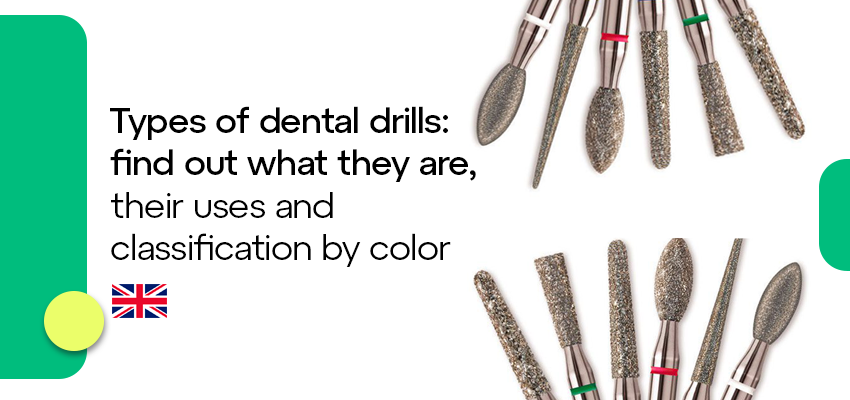Types of dental drills, find out what they are, their uses and classification by color
What are dental drills?
During training, and also in routine practice, various dental materials are used to help with the work.
Dental drills are used with so-called low and high rotation motors, which produce rotations promoting cuts and wear, in order to model restorations and remove decayed or unsupported tissue.
Restorative dental treatment depends on the way in which we use the available materials.
In this way, choosing the correct drill for each purpose will provide better results in terms of wear, contour, shape and finish.
The execution of dental procedures is carried out in detail by the Dental Surgeon. The use of a faulty material undermines the purpose of the technical application, often being liable to prejudice the appropriate procedure determined by the professional.
For this purpose, several products are available on the market, each being applied for its own purpose.
Check below the types of drills and their most recommended applications.
Types of dental drills and their uses
Carbide ball drills
They are used to remove decayed tissue, helping to create a contour in the dental tissue, creating an initial cavity shape, in addition to being used for access and removal in the pulp chamber.
When choosing a spherical drill, it becomes safer when thinking about cavity removal and access, as it does not have a tapered tip, allowing greater safety during the procedure, avoiding, to a greater extent, any accidental exposure.
However, carbide drills also have “fissures” and are commonly used to remove the axial wall during cavity preparation.
They are made of stainless steel and an active tungsten carbide tip, providing great cutting power, without posing a high risk of fracture.
Spherical diamond drill bits
Generally used when performing endodontic access, especially in restorations made with porcelain material.
As porcelain is a friable material, the application of this type of drill allows, in contact with the material, to have fewer scratches, cracks, and less fragility in terms of fracture during its application.
This type of drill is also used to wear enamel and dentin, using the engine at low speed.
If used at high speed, they must be accompanied, during wear, by air/water jets to cool the area applied, not causing an increase in temperature, which could harm the dental element.
They are made of stainless steel, with an active tip impregnated with diamonds, with high cutting power.
Transmetal
The dental element may be restored by a material, which must be accessed during the procedure.
In this case, transmetal drills help with access to amalgam, metal or porcelain restorations, as this type of drill has greater cutting power.
In their constitution, transmetal drills have a long neck, which makes it easier to visualize the removal of the necessary materials during the procedure in question.
Dental drill formats
Each drill represents a shape in relation to the active tip, which is responsible for the wear of the dental tissue and/or restorative material.
Of these, they can be of the following types: spherical, conical, cylindrical, flame, wheel, pear, oval, ringed and special.
Furthermore, diameters and shape variations determine each category.
They can be classified according to the type of rod, granulation of the active tip and its diameter.
Classification of drills by shank type
– “Friction Grip” drills: they are used close to the engine at high speed;
– “Right Angle” drills: they are used next to the contra-angle;
– “Hand Piece” drills: they are used next to the hand piece.
Classification of drills by color
Each type of drill indicates a color present on its shaft. Depending on the color, the purpose for which it is applied, as well as the particle size changes. Check out each color used and its purpose:
– Black: extra coarse grain; fast and deep cutting power; indication of wear on enamel and dentin;
– Green: extra-coarse grain; cutting power quickly; indication of wear on enamel and dentin;
– Blue: medium grain; indication for universal wear, on enamel, dentin and restorative materials;
– Red: fine grained; indication for restorative pre-finishing;
– Yellow: ultrafine grain; indication for finishing and pre-polishing in restorative resins, without cutting power.
Classification of drills by active tip diameter
According to ISO, each drill is classified according to its active tip, indicating the different diameter in terms of models and shapes.
Practical summary
Check out the options for the best application in your dental treatment:
Carbide Drill:
– Removal of decayed tissue
– Removal of the roof of the pulp chamber
– Cavity preparation (initial contour)
– Bone tissue removal
– Dental cutting/section
– Metal wear
Diamond Drill:
– Tissue wear (enamel/dentin)
– Composite resin wear
– Amalgam/metal wear
– Ceramic/porcelain wear
– Fit for prosthetic parts
Conclusion
Finally, with so many options presented to the dentist every day, it is important that they are up to date to make the best choice, providing high quality in their dental procedures.
Always stay up to date with us on the Aditek blog!




